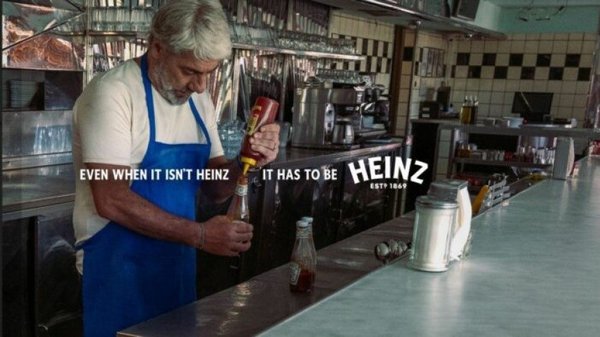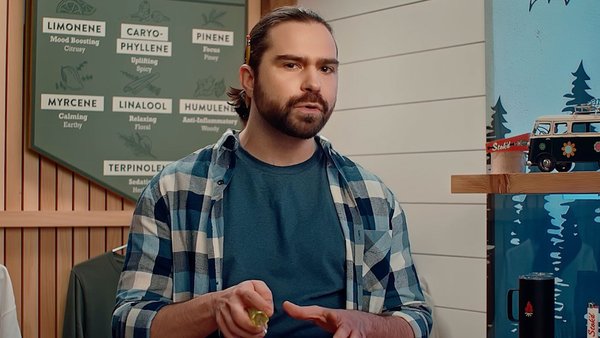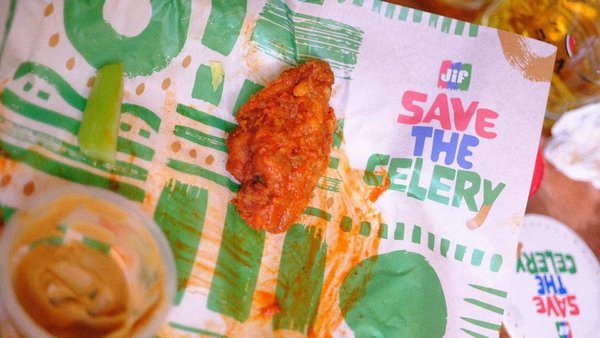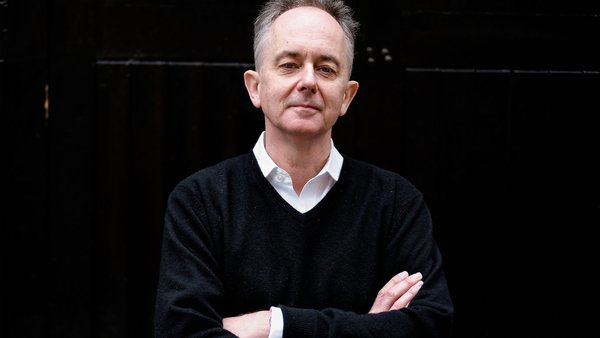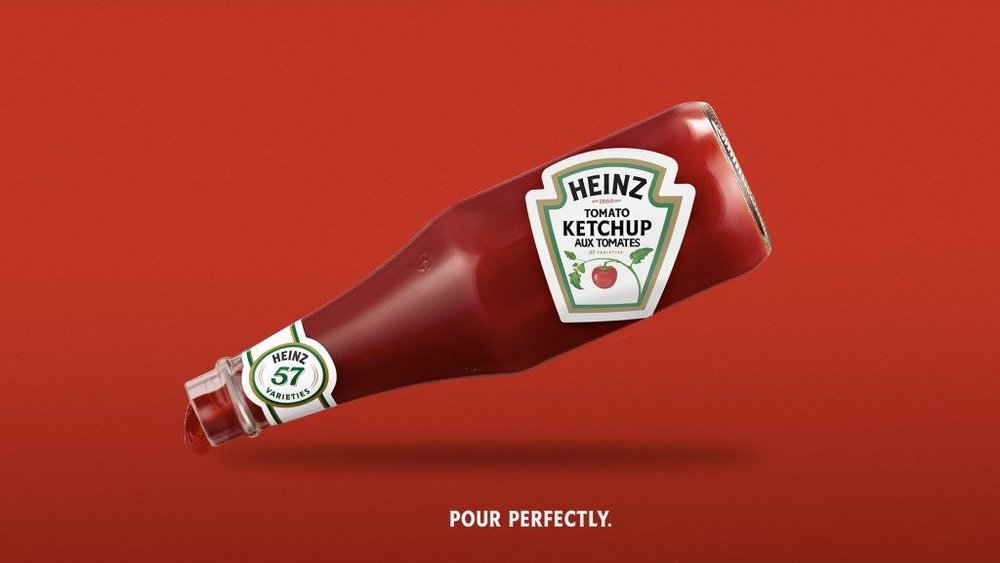
At a glance /
- Leading into the 2010s, Heinz Ketchup’s market dominance was under threat as cheaper substitutes flooded the North American market
- To regain its dominant positioning, Heinz teamed up with agency Rethink, Toronto, in 2019. Together, they developed a North American strategy of embracing creative marketing that reinforced Heinz Ketchup’s iconic standing in culture
- At the heart of Heinz Ketchup’s approach is a focus on leveraging the brand’s distinctive assets and a pursuit of earned media coverage
- Heinz Ketchup’s fast, frequent and iterative approach to marketing has seen the brand reverse a sales decline, growing US ketchup sales by a compound annual growth rate of 7% from 2017-2022, and sales in Canada by a CAGR of 4% from 2018-2022
Heinz is Ketchup, says Mike Dubrick, chief creative officer at the brand’s agency Rethink, Toronto. ‘It dominates household penetration, has massive awareness and is one of the most famous brands in the world. So, why do we even need to advertise?’ For many decades, Heinz arguably didn’t have to.
Other brands couldn’t compete with the legacy, history or affinity that Heinz had built since launching its signature red sauce in 1876. ‘People just bought Heinz,’ says Dubrick. ‘That was the best ketchup, so people never wondered why not?’
But in the years following Heinz’s merger with Kraft Foods Group in 2015, consumers were for the first time questioning their choice of ketchup, says Nina Patel, head and VP of North American brand communications for Kraft Heinz. ‘It was a bumpy start. In that moment the company struggled at focusing on building brands.’
Playing catch-up
One significant reason for Heinz Ketchup’s downturn was an influx of competitors that advertised around rational benefits such as product quality, taste and price – a tactic that the previously untouchable Heinz Ketchup started to adopt too. Julian Morgan, partner and group strategy director at Rethink, Toronto, explains that Heinz was now ‘filling the top with people coming into the brand for functional reasons, but then losing them on a brand level’.
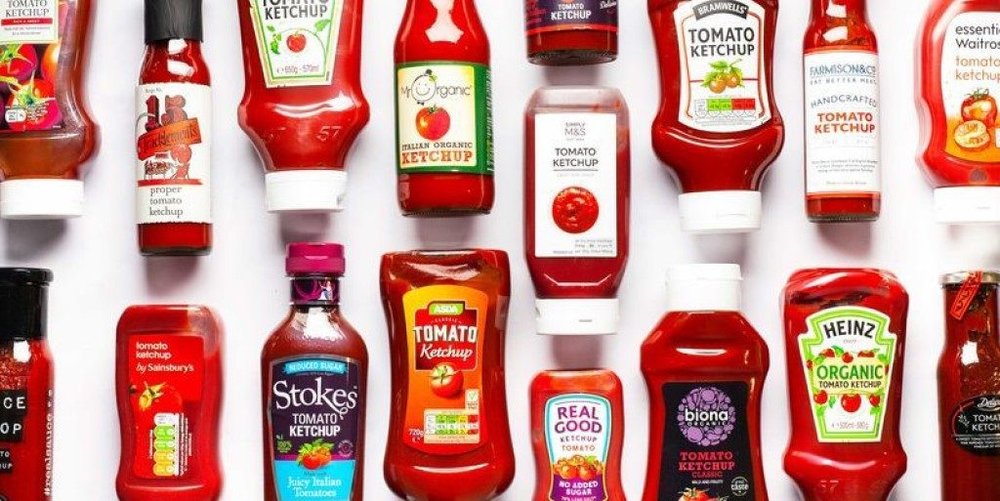
Patel confesses that during this time ‘the company’s confidence was shaken. Its culture became apologetic [as the] advertising relied on defensive ingredient claims, traditional advertising and CPG tropes. All the swagger of Kraft Heinz’s brands, once American powerhouses, was left in the rear-view.’
It wasn’t until 2019 that Heinz realised it needed a new approach. ‘The challenge was to usher in the next wave of growth with big bold ideas,’ says Patel, so Heinz Ketchup turned to new agency partners seeking true creative transformation, not just ads.
Mike Dubrick, Rethink, Toronto
Refreshing rethink
One of the agencies that received the call was Rethink. It was challenged with growing the brand and ensuring that Canadians still loved Heinz Ketchup. Over time, Rethink’s briefs have evolved to encompass the whole of North America, especially since the Kraft Heinz Canada and US teams merged in 2022.
Rethink’s strategy: to leverage the iconicness of Heinz Ketchup. ‘If you don’t act like an icon, then that status slowly erodes over time,’ explains Dubrick. The agency’s debut campaign, launched in May 2019, coincided with the first long weekend of the summer.
The social ad, which played into the abundance of beer advertising over the seasonal period, featured a glistening bottle of Heinz Ketchup with a potato wedge jammed in its neck, evoking a Corona and a wedge of lime. The playful caption also teased the connection: Eat Responsibly.
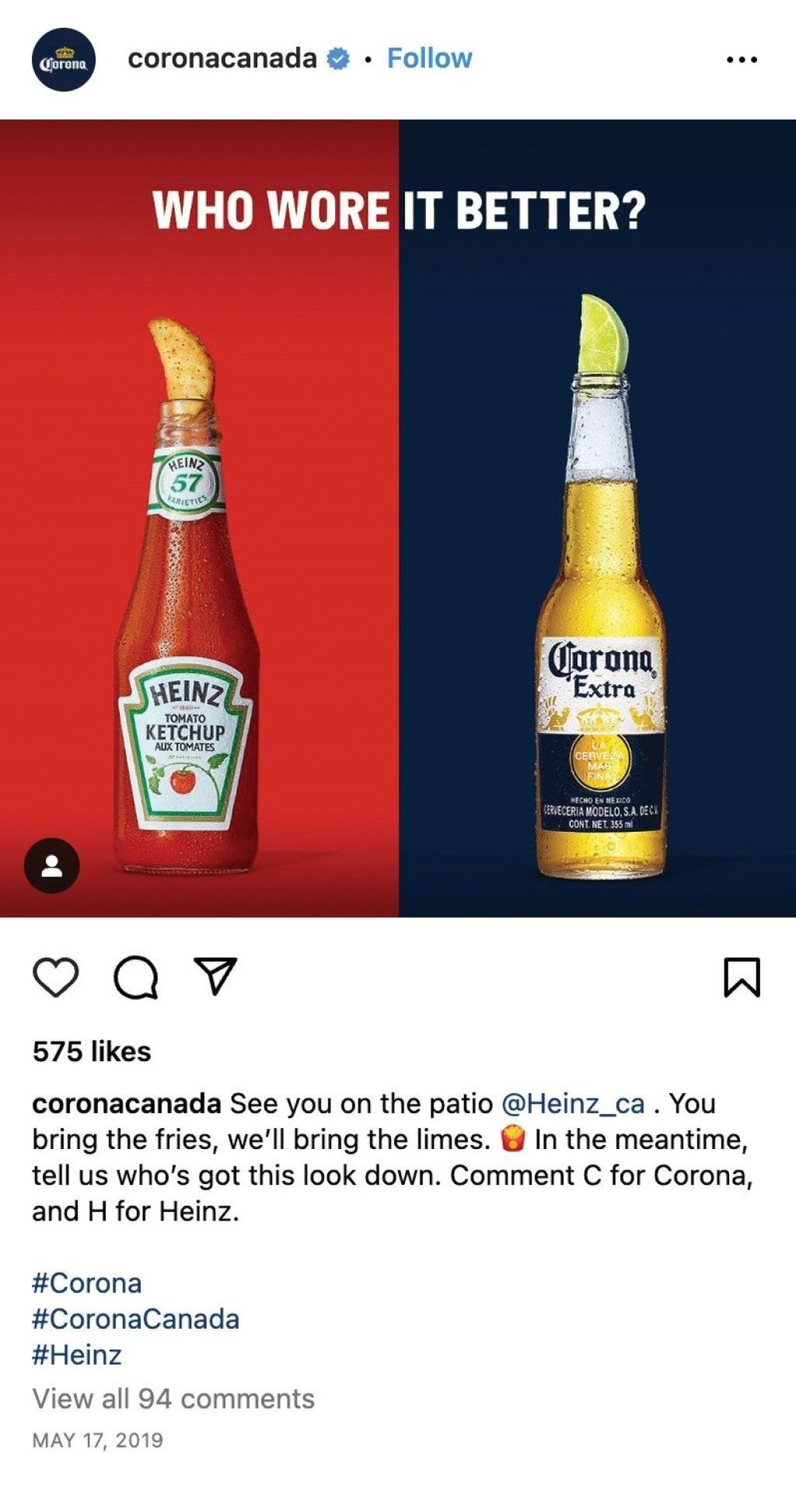
Dubrick argues that this small-scale ad was a better way to launch Heinz’s new direction than a comprehensive 360-degree campaign, the sort ‘where we cross our fingers and hope that the world rallies around it’. Crucially, it helped set the precedent for the brand to experiment and work out the best way to reinforce Heinz’s superstar status.
Comeback kid
To refresh its positioning in North America, Heinz set out two core objectives across all of its creative marketing – to break into culture to earn attention and emphasise the brand’s distinctive assets.
Jenna Thornton, director of brand PR for Kraft Heinz North America, explains why earned media is a critical KPI for Heinz: ‘When we generate ideas that earn conversation and headlines, this is a great indicator that the work we’re doing is really connecting with people, driving cultural relevance and ultimately brand love.’
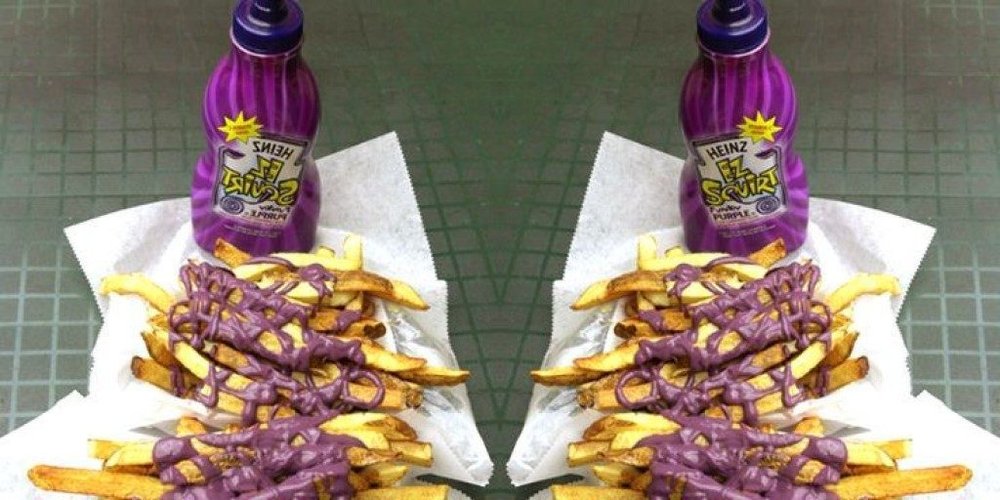
And when it came to building brand love, it was key for the brand to highlight Heinz Ketchup’s distinctive assets, something it had been neglecting for some time, says Morgan: ‘From the 2000s onwards, Heinz was making purple ketchup and doing things to try and find a new way to get people to love the brand. Rethink said, “No, it’s about finding the things that people already love and recognise, then telling that story in a more modern way.”’
Over time, Heinz and Rethink identified a template for creating successful work. The campaigns needed to be built around cultural insights, with the goal to get the work into market quickly and then develop ideas based on their reception to maximise their potential.
Mike Dubrick, Rethink, Toronto
Tasty addition
Heinz starts the briefing process by questioning ‘How do we want people to feel and react?’ says Dubrick. ‘If you only focus on what you want to say, that leads to work that doesn’t resonate with people.’ But the work still needs have an authentic connection to the Heinz Ketchup brand. ‘You see lots of other brands activating just around the cultural part, but we often ask ourselves, “Does Heinz have the authority or authenticity to say this?” If so, that’s where the brand truth and the cultural tension come together – where it totally makes sense for Heinz,’ he adds.
When Heinz called out the incongruity of hot dogs being sold in packs of 10, and buns sold in units of eight, there was no questioning the brand’s stake in the matter. Ketchup is, after all, a crucial ingredient of any good hot dog. In July 2021, the Heinz Hot Dog Pact petitioned the big shot wiener and bun makers to agree on consistent packaging for their goods. The result was 1.3 billion earned impressions, more than $13m in earned media and a Change.org petition with more than 35,000 signatures. There was real-world impact too, as Heinz convinced Wonder Bread to overhaul its supply chain and start selling buns in packs of 10.
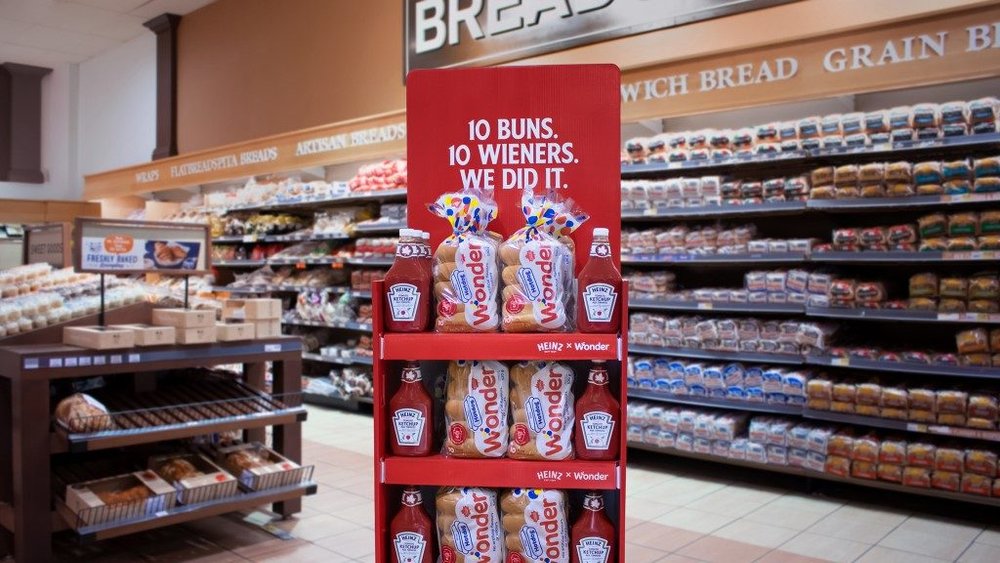
A place at every table
Heinz often draws on cultural insights in its marketing to keep the brand feeling fresh and interesting, says Dubrick. ‘The challenge is [to prevent] Heinz going from an iconic brand to fading into old fashioned nostalgia,’ he explains. ‘We really want to make sure we don’t become a brand you remember from being a kid. We want to be relevant for people now and today.’
When Heinz offered a free Impossible Whopper to Canadians stuck in traffic in July 2021, it capitalised on the buzz around Burger King’s new plant-based burger. The Heinz Bottleneck campaign, a partnership with the QSR chain and navigation app Waze, further cemented Heinz as a modern brand by making use of an unexpected digital media channel. Drivers could claim their free burger if Waze detected the speed of their car dropping to 0.045km/h – the same tentative pour speed of Heinz Ketchup. Heinz Bottleneck received more than 147 million impressions and 44% of Waze users stuck in traffic redeemed the promotion of the plant-based burger.
Proper sketchy
Heinz’s distinctive assets (of which the slow pour referenced in the Bottleneck campaign is but one) come up frequently in the brand’s advertising because they help build salience when people are in the grocery aisle.
It’s one thing for the brand to reference its own attributes, it’s all the more powerful when consumers showcase their cultural resonance. In January 2021, the Draw Ketchup campaign tapped the public to reinforce just how iconic and distinctive Heinz Ketchup is. The brand conducted a social experiment asking people across five continents to ‘draw ketchup’ and captured the results in a 60-second film.

An impressive 97% of people included Heinz iconography in their pictures (such as the 57 on the bottleneck or the vine stalk on the label), with most even writing ‘Heinz’ on the bottle itself. Heinz even created an unbranded website so members of the public could draw their own bottle of ketchup, with 250 winners receiving an official one with their design on it.
Mike Dubrick, Rethink, Toronto
Some of the images that people drew became print and outdoor ads, and were even used as labels for ketchup sold in stores across Canada. The campaign reportedly saw sales rise 12% and social engagements soar by 1,496%. Draw Ketchup won a Gold Lion in the Print & Publishing category at Cannes Lions 2022.
It can take a lot of guts for a brand to play with its distinctive assets in the way Heinz did with Draw Ketchup, but Dubrick argues that it is this remixing that helps people pay attention to a brand that’s been around since 1876. ‘By taking something that people think they know and presenting it in a way that feels unfamiliar, that unfamiliarity creates curiosity. If we then unlock that curiosity, it creates a really engaging, hopefully talkworthy piece of communication.’
When Heinz Met Sally
Heinz is so famous that it features in some of the greatest movies of all time. To demonstrate its cinematic pedigree in the run-up to the 2022 Oscars, Heinz briefly hijacked online film database IMDb to add a listing for its ketchup (headshot included).
The page featured top films that the bottle has appeared in, but before Rethink could publicise the stunt, IMDb took the profile down. Rolling with the punches, Heinz encouraged fans to post clips online of their favourite film moments featuring the product and tag the brand.
Far from killing the idea, IMDb created a catalyst for people to participate. ‘One of the things that we’ve learned over the last few years in working together with Rethink is there is a lot of ownership of Heinz Ketchup by our brand fans,’ says Nina Patel, head and VP of North American brand communications for Kraft Heinz. ‘They’re advocating for us every single day and there’s a lot of power in using them.’ Despite no royalty cheques, the Heinz on Film campaign nabbed 52 times the social engagement average for Heinz Ketchup.
Getting jiggy with it
After Heinz and Rethink have identified a potential cultural opportunity for building the brand’s iconic status, the next component for success is approving the idea quickly and getting it out into the world as soon as possible. Heinz calls this ‘saying yes’. Patel observes, ‘The amount of hours that we weren’t spending on perfecting the deck, we put all of that energy and all of those hours into creating work at the speed of culture.’
When the Covid-19 pandemic hit the world in early 2020, Heinz needed to find an opportunity that would add value, land the appropriate tone, and get the brand talked about for all the right reasons. Recognising that board games and jigsaw puzzles were soaring in popularity as people were stuck at home with nothing to do, Heinz provided a perfectly pitched distraction with a jigsaw puzzle boasting 570 pieces – all the same saucy red.
The Ketchup Puzzle went from an idea to being available for purchase in just five weeks and sold out in five days. The campaign saw Heinz Ketchup sales increase by 17.9%, generating 1.25 billion earned impression globally and resulted in more than $22m in publicity. If Heinz had wasted time debating the merits of the campaign, another brand would likely have got there first. ‘We found out shortly after launching the Heinz Puzzle that Burger King was within days of launching their own,’ says Patel. ‘We literally beat them to the punch.’
Fashionable wait
Speed may be important for Heinz Ketchup, but it’s ultimately a tool to help the brand make the biggest impact in culture. There are occasions when it’s more important to time a launch right, rather than get an idea out the door, explains Megan Lang, director of brand communications for Heinz North America.
For example, when Heinz and Rethink were developing a concept based around vintage fashion, it made sense to hold it back a few months so that it could be timed in conjunction with the lead up to New York Fashion Week (NYFW) in autumn 2022. ‘We knew that for the publications we were targeting and the conversations that we wanted to enter, launching during New York Fashion Week was going to be the most culturally relevant moment to achieve that,’ says Lang. ‘For the right ideas that take time, or that need to be saved for a given moment, we’re totally open to waiting. It’s all about balance.’
The activation sought to tap into the growing trend of branded merchandise and clothing drops, says Dubrick, but doing so in an original way that still felt true to the brand. Heinz partnered with clothing reseller ThredUp for Vintage Drip, a collection of 157 designer clothes from Louis Vuitton to Burberry, all stylishly stained with Heinz Ketchup. Influencers at NYFW were also engaged to incorporate stains into their outfits, encouraging people on social media to join the ‘pro-stain’ movement.

Not only did the collection sell out, with all the proceeds going to charity Rise Against Hunger, the campaign generated 1.75 billion impressions, had an engagement rate 583% over its benchmark and drew media coverage of 815 stories.
Go, then grow
Heinz’s strategy to break into culture is to release several initiatives at a quick rate, rather than classic 360-campaigns that demand longer lead times. The approach means, even if a project isn’t a raging success, not much is lost because less time has been invested in it. ‘When the reaction hasn’t been as great, that’s okay,’ says Dubrick, ‘because when you adopt this startup approach, you’re constantly learning from those experiences and getting better over time.’
The flipside is that when an idea does have legs, Heinz can build on it. In the case of the Ketchup Puzzle, Heinz teamed up with Walmart and Amazon on a licensing agreement so that the retailers could sell the jigsaw permanently. For Draw Ketchup, it was only after the social film captivated audiences that Heinz unleashed the website where anyone could draw their own bottle of ketchup and the best entries were used as actual product labels. The brand calls this iterative strategy ‘go, then grow’. ‘There’s always a grand plan,’ explains Dubrick, ‘but you launch it in an iterative way that allows you to be flexible, nimble and reactive as possible to the campaign as it launches into the world.’
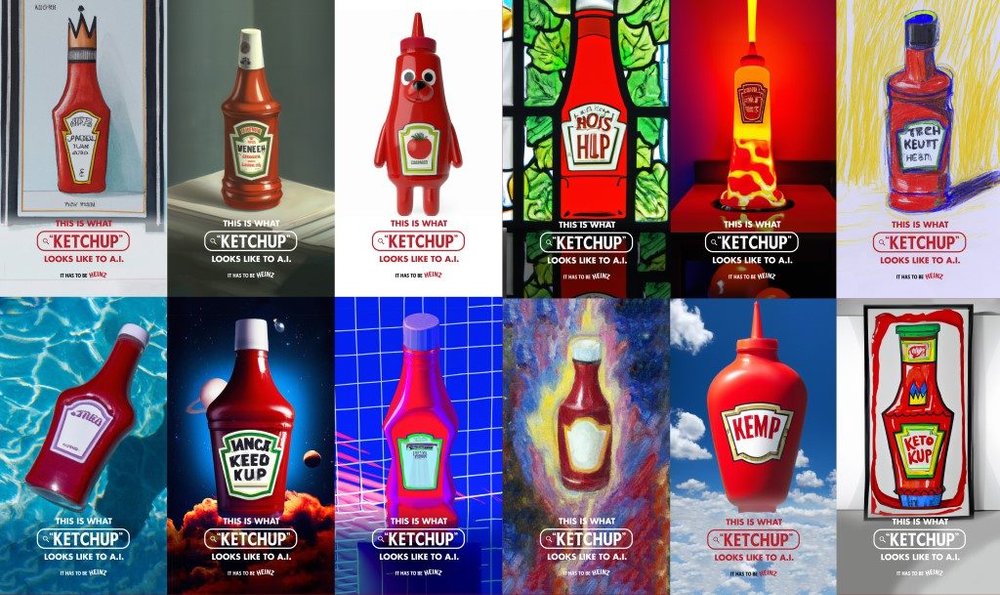
Back to the drawing board
The ‘go, then grow’ philosophy also gives Heinz Ketchup permission to revisit previous campaigns to see if there’s any potential to breathe new life into them.
More than a year after the first phase of Draw Ketchup, Heinz recreated the concept with AI image-generating tool DALL-E 2. The brand fed the AI prompts to draw ketchup in various artistic styles. When each image looked like Heinz Ketchup, it could make the point that even artificial intelligence sees ketchup as synonymous with Heinz. (The images created looked so much like Heinz that following the campaign, the DALL-E 2 development team retrained the algorithm to reduce brand bias.) Heinz then took to social media, inviting the public to give the tool their own prompts to create a virtual gallery. The AI artwork was also printed onto physical bottles.
AI Ketchup resulted in 1.15 billion earned impressions, a 38% higher engagement rate than past campaigns (with a significant presence in China, Chile and Brazil) and more than a 2,500% increase in earned media versus Heinz’s initial investment.
AI Ketchup epitomises all of Heinz’s strategic elements coming together to great effect. It’s a clever iteration on a previous campaign, was launched just a week after being ideated, and shows the brand tapping into the fervour around generative AI, all the while making a point about a product truth (that Heinz is the most famous ketchup).
Getting restaurants to trade up
According to Heinz, three out of four North Americans prefer Heinz Ketchup when eating out. Heinz sometimes relies on regular folk to help convince restaurants to stock its brand of ketchup.
An example of this in action is Tip For Heinz from November 2022. Working with agency Mischief, New York, Heinz encouraged diners to add an additional $1 tip to their bill if they realised the restaurants weren’t serving its brand of ketchup. The customers then had to share photos of their receipts online, in exchange for Heinz promising to pick up the $1 tip, plus the restaurant tip. The campaign led to 250 new business leads and achieved 200 million impressions.
Then, in March 2023, Heinz and Rethink in Canada launched a print, social and outdoor campaign featuring undercover-style photos of restaurant workers filling up Heinz Ketchup bottles with unbranded substitutes. The public was encouraged to name and shame restaurants online, with some of the suspected offenders receiving free cases of Heinz Ketchup. ‘Even when restaurants are not going to serve Heinz Ketchup, they’re still putting it in a Heinz bottle,’ says Mike Dubrick, chief creative officer at Rethink, Toronto. ‘That is a living and breathing manifestation of the “It has to be Heinz” tagline.’
Global goals
Outside of just North America, Heinz now wants to ensure that all of its markets are creatively on the same page. The brand launched its first ever global creative platform in June 2023. The ‘It has to be Heinz’ creative springboard unsurprisingly reinforces the brand’s iconic status in culture.
The irrational love that consumers have for the product was encapsulated in a 30-second brand film, created by Wieden+Kennedy New York, that depicted people all over the world getting tattoos of the Heinz logo, cars with personalised Heinz licence plates and even someone being buried with a sachet of the red sauce. Diana Frost, Kraft Heinz’s North American chief growth officer, told Contagious that ‘As a brand obsessed with our consumers, we created It has to be Heinz as our love song back to them, our fans are our muses.’
Hall of fame
There’s no question that Heinz’s strategy to reinforce its iconicness is working and the biggest proof of this is that declining sales have actually reversed in North America. US ketchup sales have grown at a compound annual growth rate of 7% from 2017-2022, and market share has increased 7 percentage points in that time period to 72% in 2022. In Canada, sales have grown at a compound annual growth rate of over 4% from 2018-2022, as Heinz continues to hold a strong market leader position of 73.6% market share.
But the last thing that Heinz Ketchup wants is to get complacent. In fact, in May 2023, parent company Kraft Heinz announced a double-digit increase in marketing spend to win share across its brands. Dubrick says, ‘It’s one thing for Heinz Ketchup to be an icon now, but we want to be an icon 50 years from now and that means we have to keep doing the work that keeps that status.’ Lang adds: ‘We have big ambitions to grow the Heinz brand and business over the next 10 years. Heinz will be one of the leading forces of growth for the company at large, both now and in the long term.’
